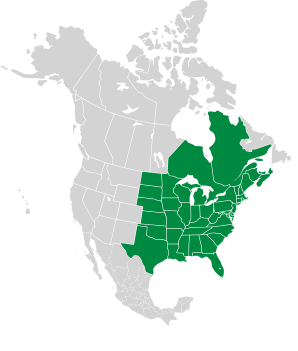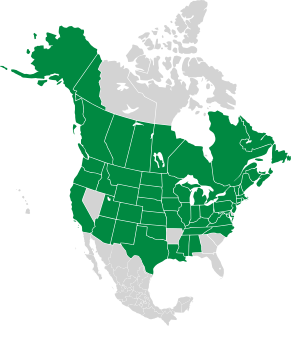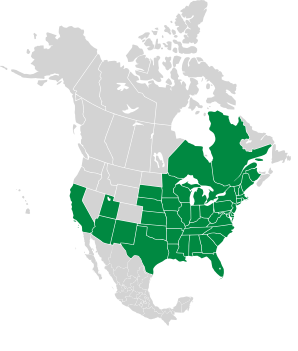Boehmeria austrina Small
Boehmeria cylindrica (L.) Sw. var. drummondiana (Weddell) Weddell
Boehmeria cylindrica (L.) Sw. var. scabra Porter
Boehmeria decurrens Small
Boehmeria drummondiana Weddell
Boehmeria scabra (Porter) Small
Urtica cylindrica L.

|
Boehmeria cylindrica (L.) Sw. False nettle, bog hemp, smallspike false nettle
False nettle is a native North American species. The name comes from is resemblance to stinging nettle, although it is not related, and lacks the stinging hairs of its namesake. Plants: 4-63″ (10-160 cm) high, and favor shady wooded areas. Stems are smooth, without the irritating hairs of stinging nettle. Leaves: Usually opposite or nearly so. They are roughly egg-shaped, with sharp tips and teeth. (More precisely, they are elliptic, lanceolate to broadly ovate.) The leaves are 1¾-7″ (5-18 cm) × ¾-4″ (2-10 cm). Flowers: The unusual flowers are the most unique feature of this species. They occur on straight spikes that emerge from the stem, in clusters of small, inconspicuous green flowers. Each spike is often tipped by a couple of small leaves. Flowers appear from July to August. The flowers are dioecious—each plant contains only male or female flowers. Fruits: Spiky little balls. |
8/31/2013 · Riverside Park, James River, Midlothian, Virginia · ≈ 6 × 9″ (15 × 22 cm) 8/27/2016 · Williams Barn and Sørhaug Woods, Groton, Massachusetts 8/31/2013 · Riverside Park, James River, Midlothian, Virginia · ≈ 9 × 6″ (22 × 15 cm) |
||||||||||||||||||||||||||||
|
See this article by Steve Brill on distinguishing
among nettles and related plants.
Here are some similar species:
| |||||||||||||||||||||||||||||
Laportea canadensis |
You are here Boehmeria cylindrica |
Acalypha rhomboidea |
|||||||||||||||||||||||||||
|---|---|---|---|---|---|---|---|---|---|---|---|---|---|---|---|---|---|---|---|---|---|---|---|---|---|---|---|---|---|
| Common Name |  |
 |
 |
||||||||||||||||||||||||||
| Plant | 2-4′ (60-121 cm) high. Stems have stiff white hairs that sting if you rub against them. | 4-63″ (10-160 cm) high, and favor shady wooded areas. Stems are smooth, without the irritating hairs of stinging nettle. | 6-24″ (15-60 cm) tall, with a stem that is hairless or covered with fine white hairs. Bracts beneath flowers, stems, and leaf undersides turn copper-colored. | ||||||||||||||||||||||||||
| Flowers | Male flower clusters are white or greenish white, in loose branching clusters. Each flower is less than ⅛″ (3.2 mm) across, with 5 petals. They appear from July to September. | Flowers occur on straight spikes that emerge from the stem, in clusters of small, inconspicuous green flowers. Each spike is often tipped by a couple of small leaves. Flowers appear from July to August. | Flowers are greenish-tan, and tiny—less than ⅛″ (3.2 mm) across. They flower from July to October. | ||||||||||||||||||||||||||
| Leaves | Alternate, up to 4″ (10 cm) × 6″ (15 cm), egg-shaped, with coarse serrations. | Usually opposite or nearly so. They are roughly egg-shaped, with sharp tips and teeth. (More precisely, they are elliptic, lanceolate to broadly ovate.) The leaves are 1¾-7″ (5-18 cm) × ¾-4″ (2-10 cm). | Leaves are alternate, lance-like or oval with sharp tips, 3½″ (8.9 cm) × 1″ (2.5 cm), with blunt serrations. | ||||||||||||||||||||||||||
| Fruit | Oblique dry seeds. | Spiky little balls. | A 3-lobed roughly spherical fruit containing 3 seeds. | ||||||||||||||||||||||||||
| Range/ Zones |
|
|
|
||||||||||||||||||||||||||
| Habitats | Moist woods, streambanks, in rich soils | Moist, deciduous woods; wet meadows; swamps, bogs, and mashes | Open woods, moist soils, gravel bars, waste ground, roadsides, railroads. | ||||||||||||||||||||||||||
| Type | Wild | Wild | Wild | ||||||||||||||||||||||||||




Online References:
The Lady Bird Johnson Wildflower Center
Plants for a Future, a resource and information centre for edible and otherwise useful plants
References:
Clemants, Steven; Gracie, Carol, Wildflowers in the Field and Forest, Oxford University Press, 2006, p. 244
7/20/2012 · J. Harry Rich Dirt Road, Groton, Massachusetts · ≈ 6 × 9″ (15 × 23 cm) 
8/26/2018 · Henry E. Cowdrey Nature Center, Lunenburg, Massachusetts · ≈ 4½ × 7″ (12 × 18 cm) 
7/20/2012 · J. Harry Rich Dirt Road, Groton, Massachusetts · ≈ 9 × 6″ (22 × 14 cm) 
8/27/2016 · Williams Barn and Sørhaug Woods, Groton, Massachusetts 
Boehmeria austrina Small
Boehmeria cylindrica (L.) Sw. var. drummondiana (Weddell) Weddell
Boehmeria cylindrica (L.) Sw. var. scabra Porter
Boehmeria decurrens Small
Boehmeria drummondiana Weddell
Boehmeria scabra (Porter) Small
Urtica cylindrica L.
Boehmeria cylindrica description by Thomas H. Kent, last updated 16 Sep 2020.
© FloraFinder.org. All rights reserved.
8/27/2016 · Williams Barn and Sørhaug Woods, Groton, Massachusetts 
8/31/2013 · Riverside Park, James River, Midlothian, Virginia · ≈ 7 × 11″ (18 × 28 cm) 
9/3/2021 · Topsham Recreational Path along the Androscoggin River, Topsham, Maine 
7/20/2012 · J. Harry Rich Dirt Road, Groton, Massachusetts · ≈ 6 × 9″ (14 × 22 cm) 
7/20/2012 · J. Harry Rich Dirt Road, Groton, Massachusetts · ≈ 14 × 9″ (35 × 23 cm) 
Range:
